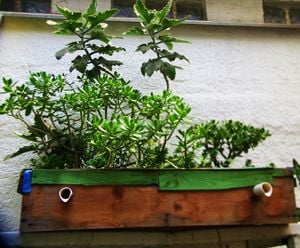
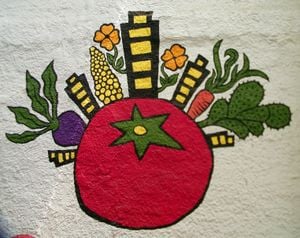
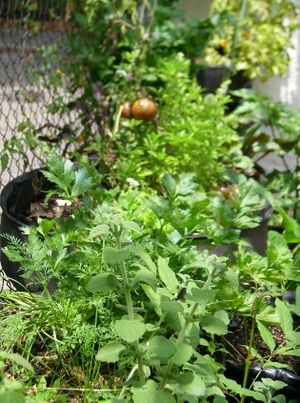
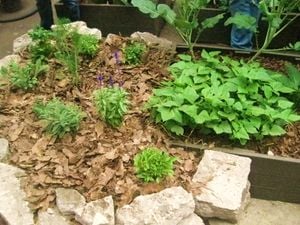
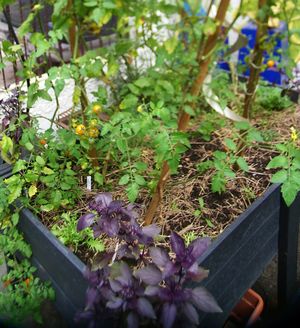
Polyculture is a type of gardening where various crops are planted interspersed among each other. As opposed to monoculture, polyculture mimics natures diversity providing the benefit of better pest management, provides better protection against total crop loss due to weather or disease, optimizes on garden space with different plant root depths, and allows plants to take and give different nutrients from and to the soil, which helps reduce the need for chemical fertilizer applications and reduce the amount of erosion and top soil loss. Below is a DIY project on polyculture planting at Sembradores Urbanos. This is one project is a series of urban gardening and sustainability projects at Sembradores Urbanos.
Background[edit | edit source]
Sembradores Urbanos is a nonprofit urban agriculture demonstration center and outreach group in Mexico City started by three women living in Mexico. There vision is to transform urban soil into green, productive, and sustainable spaces. They opened the The Center for Urban Agriculture Romita, one of the first urban agricultural community spaces in Mexico. The center demonstrates a variety of urban agriculture and organic gardening techniques as well as serving as a space for workshops and courses. This is one in a series of DIY urban gardening and sustainability projects at Sembradores Urbanos.
What is polyculture[edit | edit source]
- Polyculture includes:
- crop rotation
- multi-cropping,
- intercropping,
- companion planting,
- beneficial weeds,
- and alley cropping
- Monoculture on the other hand is a continuous planting of the same crop (like the corn belt in the United States) and this is the common model for industrial agriculture.
Benefits of Polyculture[edit | edit source]
- the diversity avoids susceptibility to total crop failure from diesease, pest outbreak, or weather.[1]
- optimizes on garden space with different plant root depths,
- allows plants to exchange different nutrients with the soil, which helps reduce nutrient and top soil depletion and in turn reducing erosion and increasing water and nutrient percolation into soil.
Designing Polyculture Gardens[edit | edit source]
Salad Garden[edit | edit source]
- In a polyculture salad garden one goal is to have the longest providing garden where you can eat from your garden through different seasons, and this is achieved by interplanting different types of salad greens that mature at different times.
- Arugala should be planted in spring for a summer harvest and fall for a early winter harvest. Also arugala enjoys a little shade (this shade can be provided be other mature leafy greens in your garden).[2]
- Lettuce can be planted all year long.
- Endive should be planted in fall (2 weeks before the last frost), and early spring (transplanting from baby's grown above 60F to avoid premature flowering).[3]
- Mustard should be planted early spring for a summer harvest and late summer for a fall harvest. This timing of growth is perfect for creating the conditions of full sun that mustard prefers, thin around mustard to allow for increased amounts of light.[4]
- Tatsoi should be planted in spring, late summer, and fall.[5]
- Watercress should be planted in spring or fall. If you cut back the watercress to 10cm in the spring it will patiently wait to come back in the fall. Also watercress prefers the shade (this can be provided by other mature leafy greens in the planter box).[6]
- Kale prefers the cold and the taste is best when touched by a bit of frost. Kale should be planted 4-6 weeks before the last frost in spring. It does well companion planting with lettuce and celery and kale can be planted in as small as a 6-inch container.[7]
- Calendula can be planted all year long.
- Remember these leaves can be cut individually so that it can produce once to three times more, extending the life of the plant and your harvest.
- If you are cooking for two, one reclaimed tire offers enough space for cultivating your own salads. If you are cooking for more people you can either add another tire or plant your salad in a raised bed.
Salsa Garden[edit | edit source]
Combine tomatoes, chiles, cilantro and onions in a container. Planting tomatoes in the center allows it enough space for growth. The onion is planted on the edge of the container to repel any pest. Meanwhile, the peppers can be planted inter cropped with cilantro around the tomato. This design works for a reclaimed tire container that is lined with a plastic or clay packed bottom, or it can work in a raised bed. Check out the link on Raised Beds at Sembradores Urbanos.
Contact[edit | edit source]
References[edit | edit source]
- ↑ Youyong Zhu, Hairu Chen, Jinghua Fan, Yunyue Wang, Yan Li, Jianbing Chen, JinXiang Fan, Shisheng Yang, Lingping Hu, Hei Leung, Tom W. Mew, Paul S. Teng, Zonghua Wang & Christopher C. Mundt. Genetic diversity and disease control in rice. Nature 406, 718-722 (17 August 2000).
- ↑ Bonnie Plants. http://web.archive.org/web/20120202043609/http://www.bonnieplants.com:80/LearnGrowLibrary/HowtoGrowBonnieVarieties/tabid/128/ID/248/How-to-Grow-Arugula.aspx
- ↑ The Essential Garden Guide. http://www.essentialgardenguide.com/garden-vegetables-planting/30/Endive-or-Escarole/
- ↑ How to Grow Mustard. http://web.archive.org/web/20141225103532/http://www.ehow.com:80/how_2156698_grow-mustard.html
- ↑ Kitazawa. http://www.kitazawaseed.com/seed_062-78.html
- ↑ Growing Watercress. http://grow-herbs.net/growing_watercress.php
- ↑ Harvest to Table. http://www.harvestwizard.com/2009/02/how_to_grow_kale.html